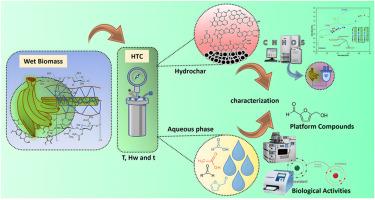Hydrothermal carbonization of Colombian plantain peels: Physicochemical properties, thermal behavior, and bioactive potential
IF 5.8
2区 化学
Q2 CHEMISTRY, MULTIDISCIPLINARY
引用次数: 0
Abstract
Hydrothermal carbonization (HTC) is a promising technology for the conversion of biomass into high-added-value products, offering an effective treatment for organic waste with high moisture content. In this study, the impact of reaction conditions on the distribution of products generated from Dominico Harton plantain peel, an abundant agro-industrial waste in Colombia, was investigated. The HTC of plantain peels was investigated at various temperatures (150–230 °C), biomass moisture content (50–85%), and residence times (2–4 h). The yield of hydrochar decreased with increasing temperature, ranging from 41.59 to 82.30% at 85% moisture content, 25.19–60.29% at 65% moisture content, and 26.29–49.07% at 50% moisture content. The results indicated that the energy and mass performance of hydrochar are influenced mainly by the moisture content of the biomass and the reaction temperature. At 230 °C and 85% moisture content, the energy densification (ED) ratio and the higher calorific value (HHV) of hydrochar reached maximum values of 1.69 and 27.70 MJ kg−1, respectively. The relationships among the elemental compositions (H/C and O/C) observed in the Van Krevelen diagram suggest that the carbonization process was influenced mainly by dehydration reactions. Thermogravimetric analysis confirmed the increased thermal stability of hydrochar compared with that of fresh raw material. HTC process water analysis revealed acidic pH values (3.76–5.00), high chemical oxygen demand (24447–92963 mg O2 L−1), and increased electrical conductivity (11.45–18.55 mS cm−1) with increasing temperature. The concentration of 5-hydroxymethylfurfural (5-HMF) reached maxima of 980.9 and 1418.3 μg mL−1 at 190 °C for 2 h and 4 h, respectively. The total phenolic content and antioxidant activity were highest at 170–190 °C, suggesting the potential for valuable bioactive compounds in HTC process water. Principal component analysis (PCA) indicated that the physicochemical properties of the hydrochar remained stable within certain temperature ranges, particularly between 210 and 230 °C, where improved energy characteristics were noted. This suggests that operating within this range is both energy efficient and cost effective for process optimization. These findings highlight the effectiveness of HTC in managing plantain residues in Colombia, producing hydrochar with desirable fuel properties, and generating process water for potential applications in health, fine chemicals, and agriculture.

哥伦比亚大蕉皮的水热碳化:物理化学性质、热行为和生物活性潜力
水热碳化(HTC)是生物质转化为高附加值产品的一项有前途的技术,为处理高含水量有机废物提供了有效的方法。在本研究中,研究了反应条件对哥伦比亚丰富的农用工业废弃物dominicharton大蕉皮产物分布的影响。研究了车前草皮在不同温度(150 ~ 230℃)、生物质含水量(50 ~ 85%)和停留时间(2 ~ 4 h)下的HTC。随着温度的升高,煤的产率逐渐降低,85%含水率为41.59 ~ 82.30%,65%含水率为25.19 ~ 60.29%,50%含水率为26.29 ~ 49.07%。结果表明,生物质的含水率和反应温度主要影响水合物的能量和质量性能。在230℃、85%含水率下,水合物的能量密度比和高热值分别达到1.69和27.70 MJ kg−1的最大值。在Van Krevelen图中观察到的元素组成(H/C和O/C)之间的关系表明,碳化过程主要受脱水反应的影响。热重分析证实,与新鲜原料相比,碳氢化合物的热稳定性有所提高。HTC工艺水分析显示,pH值为酸性(3.76-5.00),化学需氧量(24447-92963 mg O2 L−1)高,电导率(11.45-18.55 mS cm−1)随温度升高而增加。5-羟甲基糠醛(5-HMF)浓度在190℃作用2 h和4 h时分别达到最大值980.9和1418.3 μ mL−1。总酚含量和抗氧化活性在170-190°C时最高,表明HTC工艺水中可能存在有价值的生物活性化合物。主成分分析(PCA)表明,在一定温度范围内,特别是在210 ~ 230℃之间,烃类的物理化学性质保持稳定,能量特性得到改善。这表明,在此范围内操作既节能又具有成本效益的过程优化。这些发现突出了HTC在哥伦比亚管理大蕉残留物、生产具有理想燃料特性的碳氢化合物以及生产用于卫生、精细化学品和农业的潜在应用的工艺用水方面的有效性。
本文章由计算机程序翻译,如有差异,请以英文原文为准。
求助全文
约1分钟内获得全文
求助全文
来源期刊

Sustainable Chemistry and Pharmacy
Environmental Science-Pollution
CiteScore
8.20
自引率
6.70%
发文量
274
审稿时长
37 days
期刊介绍:
Sustainable Chemistry and Pharmacy publishes research that is related to chemistry, pharmacy and sustainability science in a forward oriented manner. It provides a unique forum for the publication of innovative research on the intersection and overlap of chemistry and pharmacy on the one hand and sustainability on the other hand. This includes contributions related to increasing sustainability of chemistry and pharmaceutical science and industries itself as well as their products in relation to the contribution of these to sustainability itself. As an interdisciplinary and transdisciplinary journal it addresses all sustainability related issues along the life cycle of chemical and pharmaceutical products form resource related topics until the end of life of products. This includes not only natural science based approaches and issues but also from humanities, social science and economics as far as they are dealing with sustainability related to chemistry and pharmacy. Sustainable Chemistry and Pharmacy aims at bridging between disciplines as well as developing and developed countries.
 求助内容:
求助内容: 应助结果提醒方式:
应助结果提醒方式:


